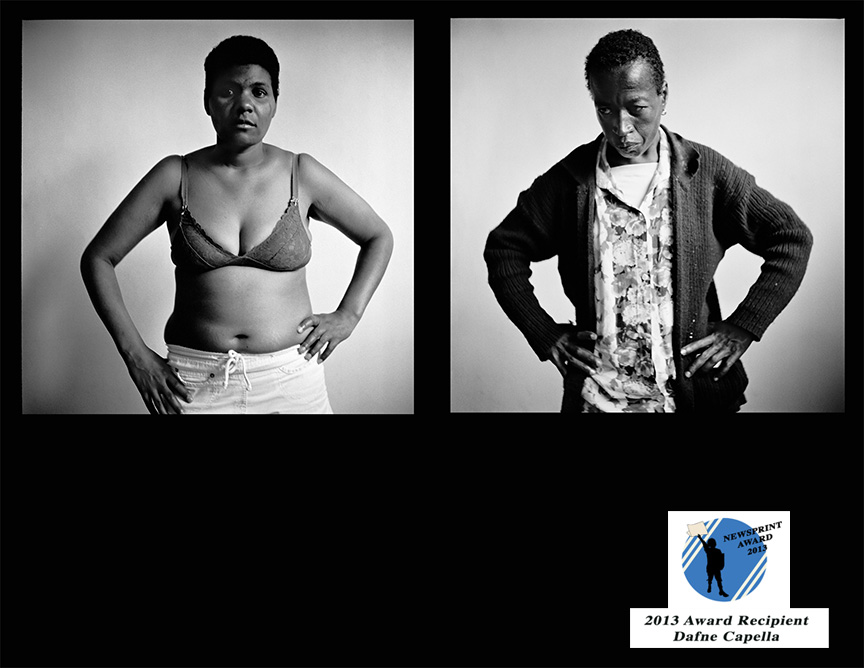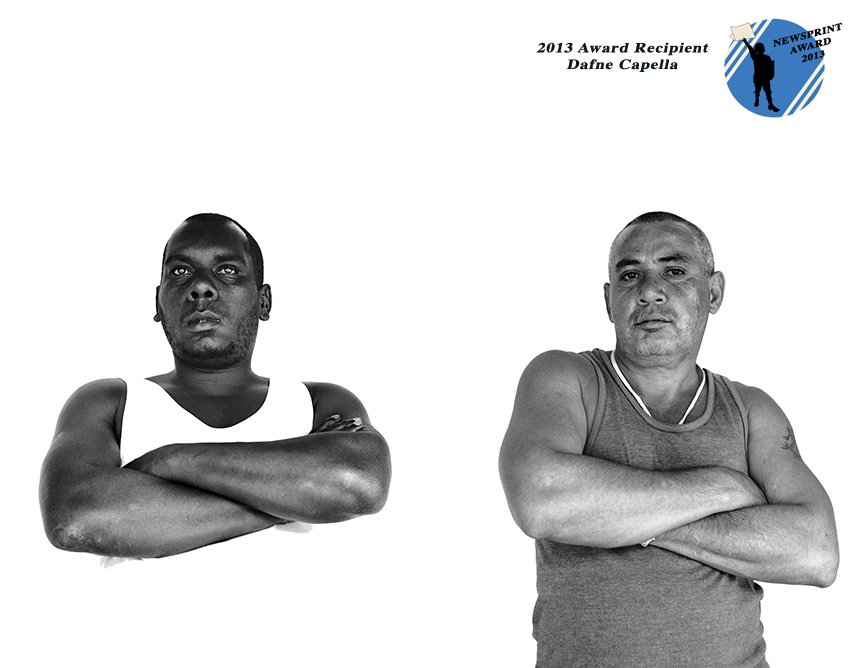Congratulations! 2013 NEWSPRINT AWARD WINNER, “26 patients, 1 employee and 1 visitor at Santa Lucia’s Mental Institute” BY Dafne Capella
Thank you so much for waiting!
We spent the last month looking through every submission and are impressed with the quality and scope of the work.
There were hard decisions to make. This award is intended to stimulate self-publishing and self-distribution of your work, we are sure that many of these projects will find their way to the printing page.
Here we go, we are please to announce that 2013 Newsprint Award winner is “26 patients, 1 employee and 1 visitor at Santa Lucia’s Mental Institute” BY Dafne Capella.
“Dafne Capella convinced me with a project of bold and striking portrait images accompanied by a very intriguing story that compelled me to look at the images over and over again as I tried to unravel the mystery that they contained.” – Matthew Carson, 2013 Newsprint Award juror –
The newsprint publication of her work will be overseen by bookdummypress, printed and exhibited at the Reminders Photography Stronghold Gallery in Tokyo, September 2013.
Also, her work will be projected at the OBSCURA international photo festival from June 21st in Penang, Malaysia.
We will give you updates with the process, please stay tuned.
Congratulation to Dafne!

©Dafne Capella / Winner 2013 newsprint award

©Dafne Capella / Winner 2013 newsprint award

©Dafne Capella / Winner 2013 newsprint award
About 26 patients, 1 employee and 1 visitor at Santa Lucia’s Mental Institute
In 1973, psychologist David Rosenhan assembled 8 people- including himself- with no history of psychiatric problems. Each person was sent to a different mental hospital across America, where they claimed to be hearing voices saying the words “hollow”, “empty” and “thud”. Apart from these auditory hallucinations, they shouldn’t fake any other aspect of their behavior, nor tell any lies about their lives.
They were all diagnosed with psychiatric disorders – 7 with schizophrenia and 1 with manic-depressive psychosis-, admitted to the institutions and given powerful antipsychotic drugs.
Displeased with the study’s outcome, one of the hospitals then challenged Rosenhan to send more pseudo-patients to its facility, guaranteeing that, being aware of the existence of “fakes”, the staff would be able to detect them. Rosenhan agreed and, a month later, out of 193 new patients, 41 had been identified as potential false ones.
But Rosenhan had sent no one to the hospital.
Although the concept of madness has shifted through time – often due to advances in scientific knowledge and to developments in Psychiatry itself – it has always served political and social systems of control as a category that circumscribes and alienates what is considered offensive or anti-social behavior.
Conditions like epilepsy and hypochondria had once been catalogued as madness due to their “strange” symptoms and lack of a clear organic base; homosexuals and women who wanted a divorce or cheated their husbands were once “treated” with electroshocks and institutional confinement.
Up to now, the socially unusual is associated with insanity.
Popular imagination tends to stereotype the insane as wild or disarranged in appearance, often creating cultural expectations of an external irrationality, a visually grotesque madman.
The insane should be easily recognized as socially other.
But, is this perception accurate? Is insanity always expressed visually?
Can a picture reveal (or hide) madness?
For 6 months during the year of 2007, I photographed the interns and staff of Santa Lucia’s Public Mental Institute in Rio de Janeiro, Brazil.
While Dr. Rosenhan conducted an experiment to investigate psychiatric diagnosis, I wanted to investigate social labels, challenging the viewers (and myself) on our certainties and pre assumptions of madness and its visual representations.
About Dafne Capella
I’m from Brazil, and I have been living in New York for the past 2 years. I hold a Master degree in Documentary Filmmaking from Paris 8 University, and a BA in Social Communications from the Federal University of Rio de Janeiro (UFRJ).
While still in College, I worked as a TA for classes at the photo studio and lab through half of the period I was there. I started an internship in photojournalism at the State Assembly of Rio de Janeiro, where I was latter hired. I graduated in “Audiovisual Productions” with a photographic essay made in a mental hospital.
When interning at the State Assembly, I was hired to work at the Human Rights Commission as Audiovisual Production Coordinator. Although I had multiples tasks – as a photographer and managing media content – the main one was to produce short documentary films on themes the Commission was dealing with.
There, I produced and directed “Women and the Favela” – documentary about the police violence in the favelas, through the perspective of the women who live there – and “Brazil 8069” – about the violations at the penal system for underaged boys. They were largely distributed through Brazil and Europe with the purpose of expanding the debate on subjects often ignored by the general public.
In 2009, I was accepted at Paris 8 University, and for my graduate project I produced and directed the documentary POLINTER. The film deals with the overcrowded jail system in Rio de Janeiro. A system that legally doesn’t even exist but houses more than 4000 people under inhuman conditions.
From to 2011 to 2012, I took a one-year program on cinematography for documentary in New York City, where I’ve been working ever since.
The Newsprint Award 2013 in partnership with OBSCURA Festival!
The finalists’ and winner’s work of the Newsprint Award 2013 will be showcased at the final night party of OBSCURA Festival, on the 30th of June 2013.


